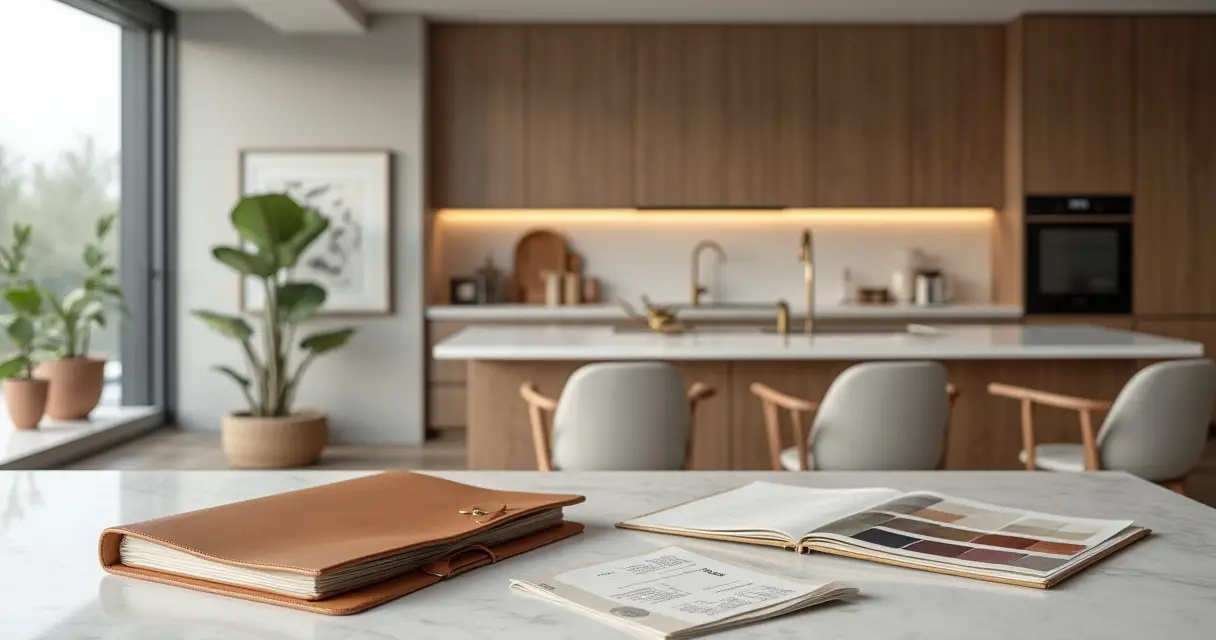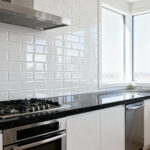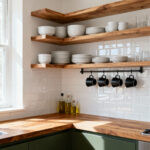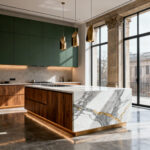Picture this: You’re standing in your newly finished kitchen. The light is hitting the quartz countertop just right, catching the edge of a solid brass handle. There’s no clutter, because everything has a designated, hidden home. You pull a chilled bottle from a beverage center that blends seamlessly with the cabinetry and pour a glass. The space feels calm, cohesive, and incredibly functional. It doesn’t just look expensive; it feels intelligent. That feeling? That’s what a Luxury kitchen renovation is all about.
It’s not just about slapping in a Wolf range and some marble. Anyone can do that. It’s about orchestrating a series of deeply considered decisions to create a space that supports and elevates your life. I spent years shooting architecture, learning to see how light, texture, and flow interact. The best spaces weren’t always the biggest or most expensive—they were the smartest. Let’s break down how you actually achieve that, separating what truly matters from the noise.
Crafting Your Vision: The Foundational Planning for Luxury (Part 1)
Before you pick a single tile, you have to nail the blueprint. This is where most people get it wrong. They jump straight to Pinterest boards and appliance showrooms, but the real groundwork is done with a pen and paper, thinking critically about how you actually live.
1. Conduct a Comprehensive Lifestyle Assessment for Personalized Design
People always ask me, “Where do I start?” I tell them to forget the kitchen for a second and just think about their life. Are you the family that hosts Thanksgiving for thirty? Or are you a couple who heats up takeout and makes great coffee? Your kitchen’s design should be a direct reflection of your daily and not-so-daily rituals, not some generic ideal you saw in a magazine. A truly bespoke design is one where the layout anticipates your next move.
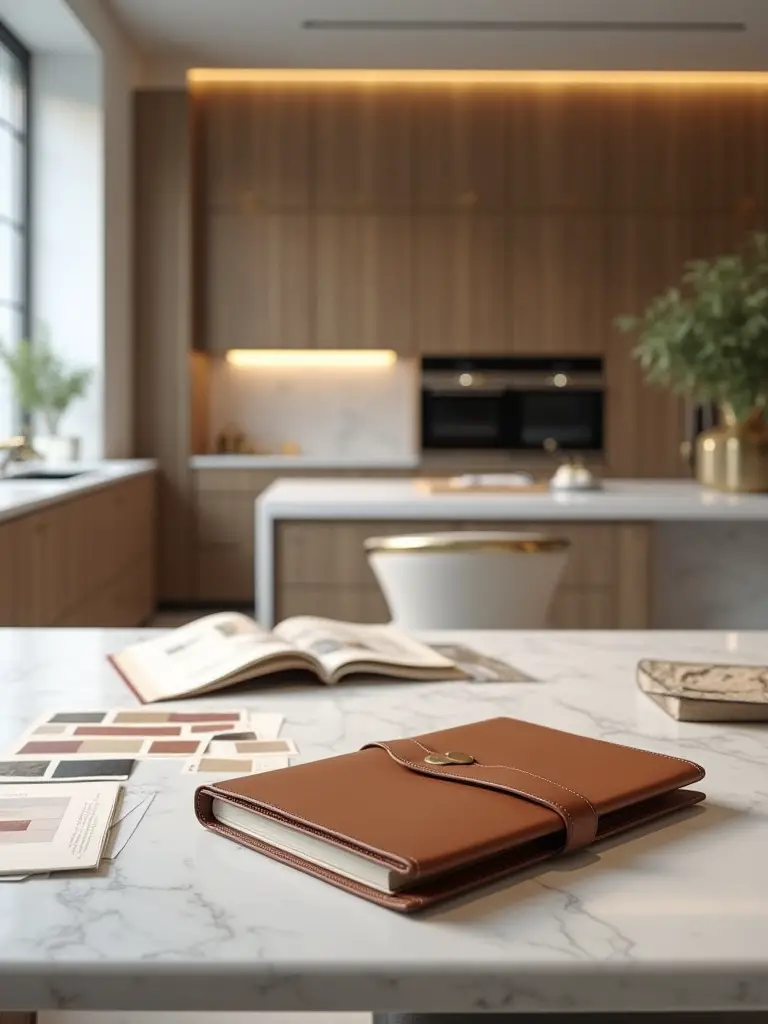
When you nail this, your kitchen feels like an extension of you. Efficiency skyrockets because the things you use most are exactly where your hand naturally reaches. I once worked with a client who was an avid baker. We designed a lowered marble countertop section specifically for rolling dough and an appliance garage right below it for her stand mixer. That small detail transformed her entire baking process. Don’t just design a kitchen; design your specific workflow.
This meticulous planning isn’t just for comfort; it sets the stage for every other decision and prevents costly changes down the road.
2. Secure a Specialized Luxury Kitchen Designer for Bespoke Concepts
“Can’t I just use a general contractor?” I hear this all the time, and it’s a huge mistake. A great contractor can build anything, but a specialized kitchen designer understands the unique ergonomics of a high-performance culinary space. They know the precise clearance needed for a 48″ integrated refrigerator door to swing open without hitting the island. They have access to custom cabinet makers and exclusive materials you can’t get at a big box store. They orchestrate the entire project, ensuring the plumber, electrician, and cabinet installer are all working from the same precise plan.
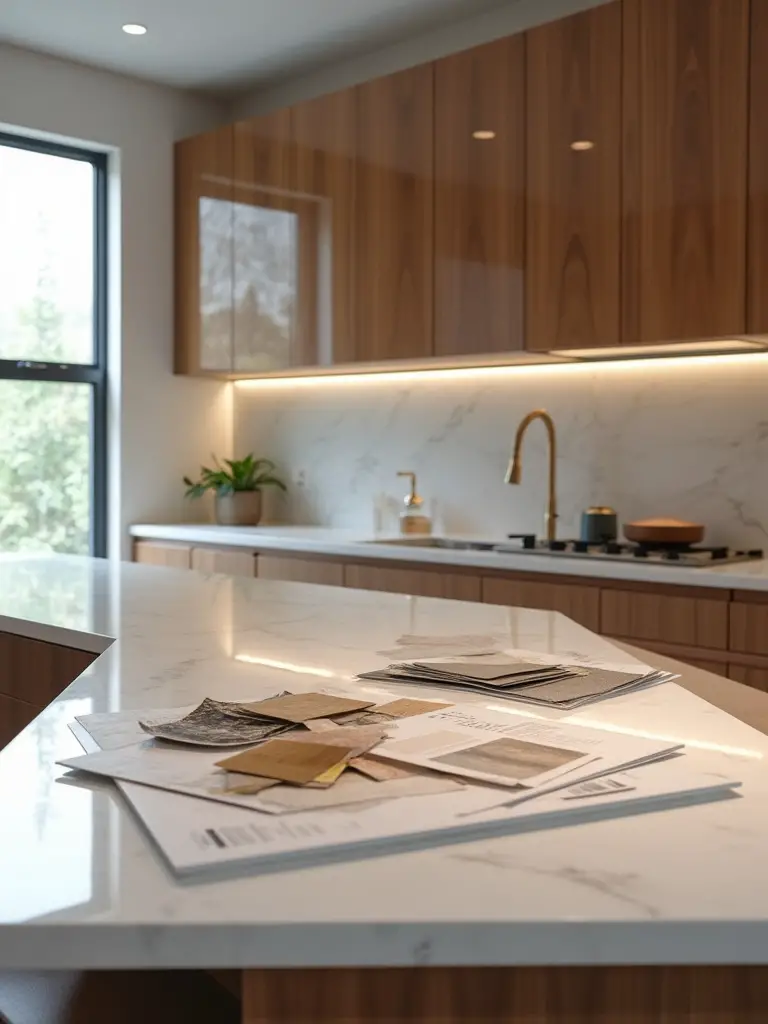
I used to think I could design spaces on my own. Then I watched a designer solve a problem with a complex, L-shaped island that I’d stared at for days. They created distinct zones for prep, cooking, and socializing that made the awkward space feel intentional and expansive. Their expertise isn’t a cost; it’s an investment that prevents thousand-dollar errors and ultimately delivers a space that functions as beautifully as it looks.
Hiring the right expert is the ultimate shortcut to getting exactly what you want, even when you can’t quite articulate it yourself.
3. Establish a Realistic and Detailed Budget Envelope
Let’s be honest: this is the least glamorous part, but it’s the absolute bedrock of your project. A “budget” isn’t just a number you hope not to exceed. It’s a detailed, line-itemed financial plan that dictates every choice. A huge mistake I see is clients having a total number in mind, say $150,000, but failing to break it down. They splurge on a top-of-the-line range and then realize they have nothing left for the intelligent lighting that will actually make the space usable.
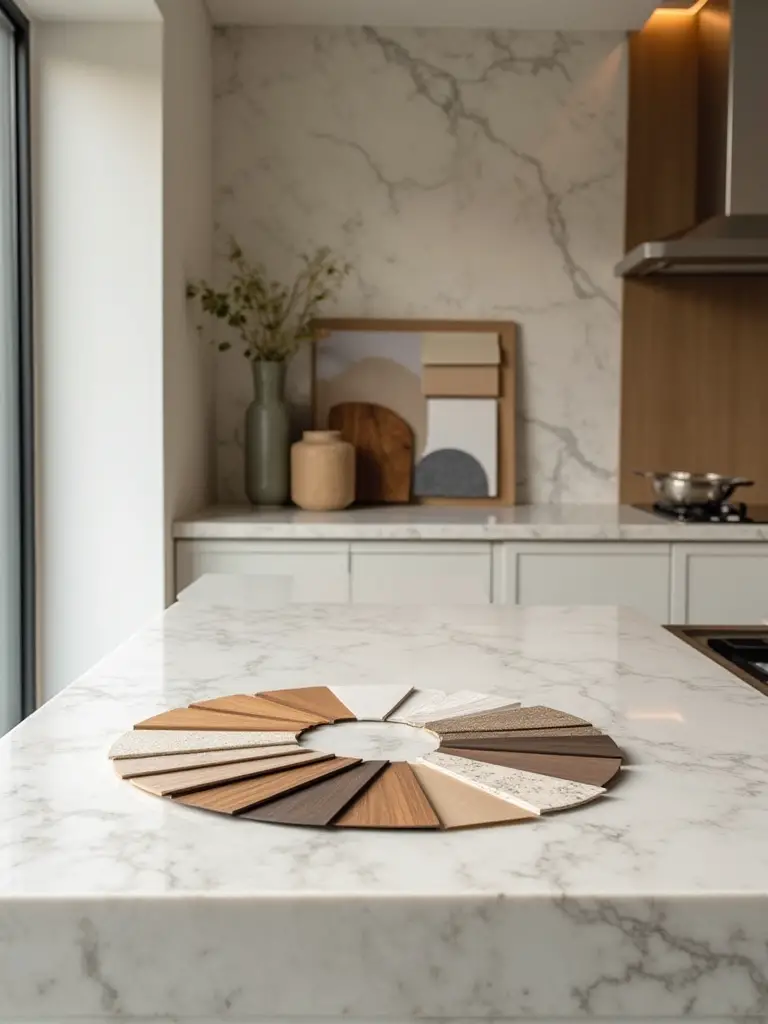
A proper budget allocates percentages: cabinetry (30-40%), appliances (15-25%), countertops (10-15%), and so on. Critically, you must include a 15-20% contingency fund. Every. Single. Time. When your contractor opens a wall and finds unexpected plumbing that needs rerouting, that’s what your contingency is for. It’s not “if” you’ll use it; it’s “when.” Without it, you’ll be forced to compromise on a key feature later in the project.
This isn’t about limiting you; it’s about empowering you to make smart trade-offs and allocate funds where they will have the most impact.
4. Evaluate Architectural Integration with Your Home’s Style
The most breathtaking luxury kitchens are the ones that feel like they’ve always been there, even if they’re brand new. You can’t just drop an ultra-modern, high-gloss kitchen into a 1920s Tudor and expect it to work. The design must respect the architectural language of your home—the lines, the materials, the scale. It’s about creating a harmonious flow, not a jarring interruption.
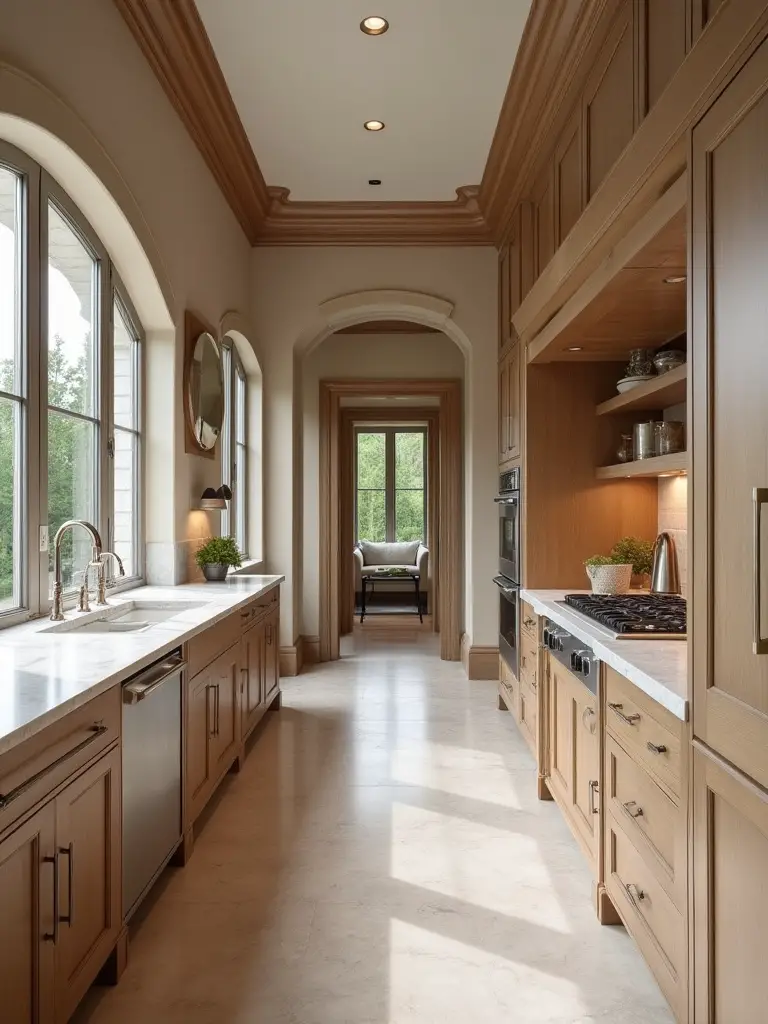
I photographed a home once where a renovation had completely ignored this. The main house was a beautiful, rustic craftsman, but the kitchen was a stark white, minimalist box. It was like two different worlds colliding. It tanked the home’s value because it felt so disjointed. True luxury is cohesive. You can absolutely put a modern kitchen in an old home, but it has to be a thoughtful conversation between old and new—perhaps by using natural wood tones or repeating a window casing detail.
Before you get carried away with a specific look, step back and consider the story your entire home is telling. The kitchen needs to be a seamless chapter, not a random insert.
Crafting Your Vision: The Foundational Planning for Luxury (Part 2)
Once you’ve got the big-picture plan, it’s time to zoom in on the geometry and the soul of the space. It’s about making every square inch work harder and making choices that align with modern values.
5. Strategize Space Optimization for Seamless Flow and Functionality
A big kitchen isn’t automatically a good kitchen. I’ve seen massive kitchens that were exhausting to work in because the fridge, sink, and cooktop were spread too far apart. Luxury isn’t about size; it’s about intelligent, ergonomic flow. It’s about minimizing the number of steps you take between tasks and creating clear zones for cooking, cleaning, and storage so that multiple people can use the space without constantly bumping into each other.
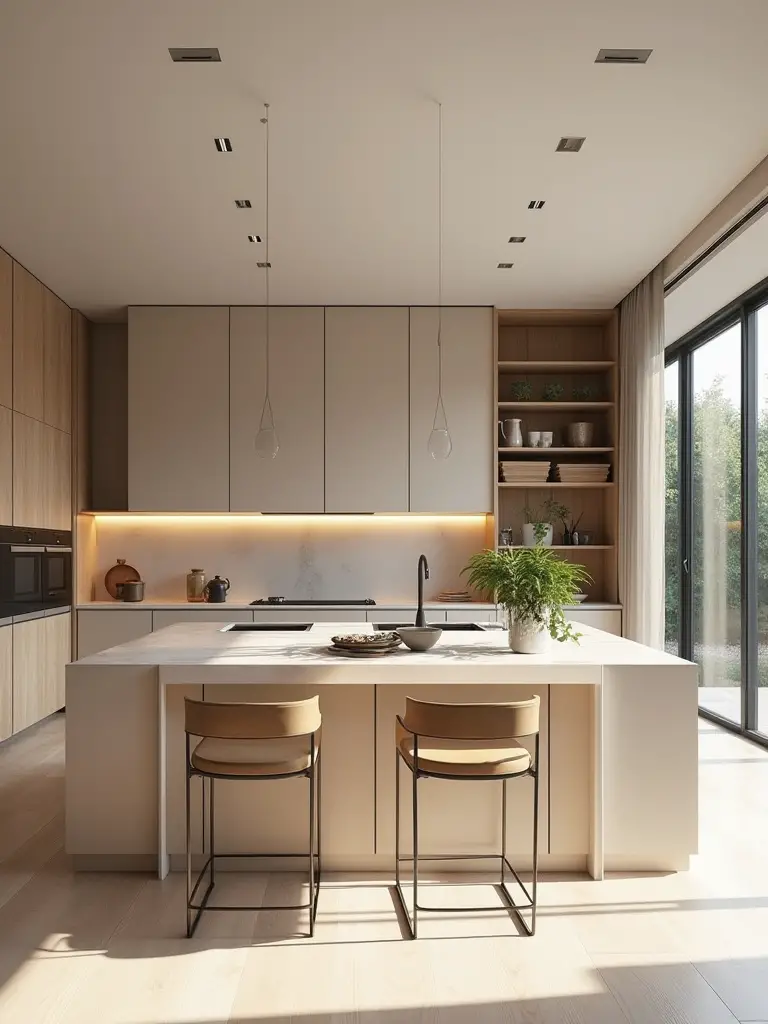
The “work triangle” is a classic concept for a reason, but in larger, modern kitchens, it evolves into “work zones.” You might have a prep zone on the island with a secondary sink, a cooking zone by the range, and a cleanup zone by the main sink and dishwasher. The goal is effortless movement. Every cabinet, drawer, and appliance is placed with intention, ensuring you can unload the dishwasher or grab spices without a frustrating journey across the room.
Think of it like choreography. You’re designing a dance, and the space should support your movements, not obstruct them.
6. Prioritize Sustainable Material Sourcing for Enduring Value
Everyone says they want high-end materials, but what does that even mean anymore? Today, true luxury is increasingly tied to sustainability and craftsmanship. It’s about choosing materials that are not only beautiful and durable but also responsibly sourced. Think reclaimed wood from an old barn for your island, countertops made from recycled glass, or FSC-certified cabinetry.
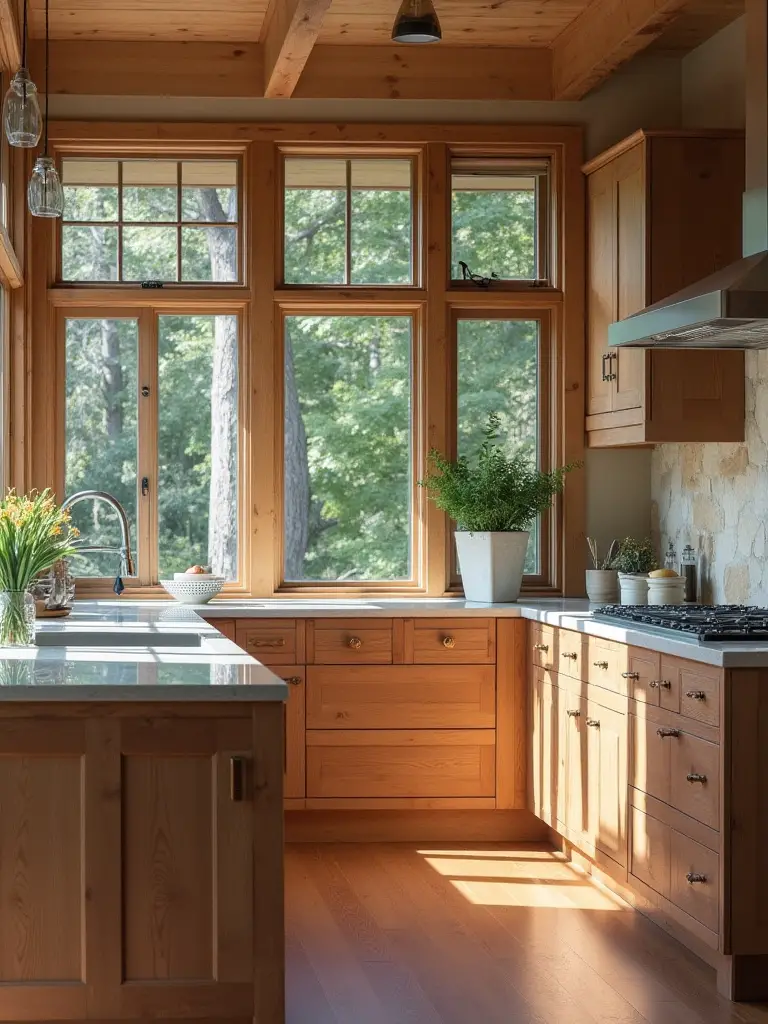
This isn’t just about feeling good; it’s a smart financial move. Eco-friendly and non-toxic materials create a healthier indoor environment. They often come with a story and a level of artistry that mass-produced products can’t match. And discerning buyers recognize and value this. They see a kitchen with reclaimed beams and know it’s a home built with thoughtfulness and quality, which directly translates to higher resale value.
“True luxury is evolving beyond just expensive finishes to encompass values. A kitchen that tells a story of responsible sourcing and artisan craftsmanship feels inherently more valuable.”
This choice grounds your high-tech kitchen with something real and timeless.
Elevated Choices: Materials, Appliances, and Expert Execution (Part 1)
Now we get to the fun part—the tangible elements that you’ll see and touch every day. These choices are where your vision comes to life, turning the abstract plan into a physical reality.
7. Invest in Bespoke Cabinetry with Custom Storage Solutions
Off-the-shelf cabinets are for regular kitchens. In a luxury project, cabinetry is custom furniture for your kitchen. Bespoke means it’s built to the exact dimensions of your space, from floor to ceiling, eliminating awkward gaps and wasted inches. But the real magic is on the inside. You’re not just buying boxes; you’re designing purpose-built storage. Think deep drawers with custom dividers for pots and pans, a vertical pull-out pantry for spices, or an appliance garage with a lift-up door that hides your toaster and coffee maker.
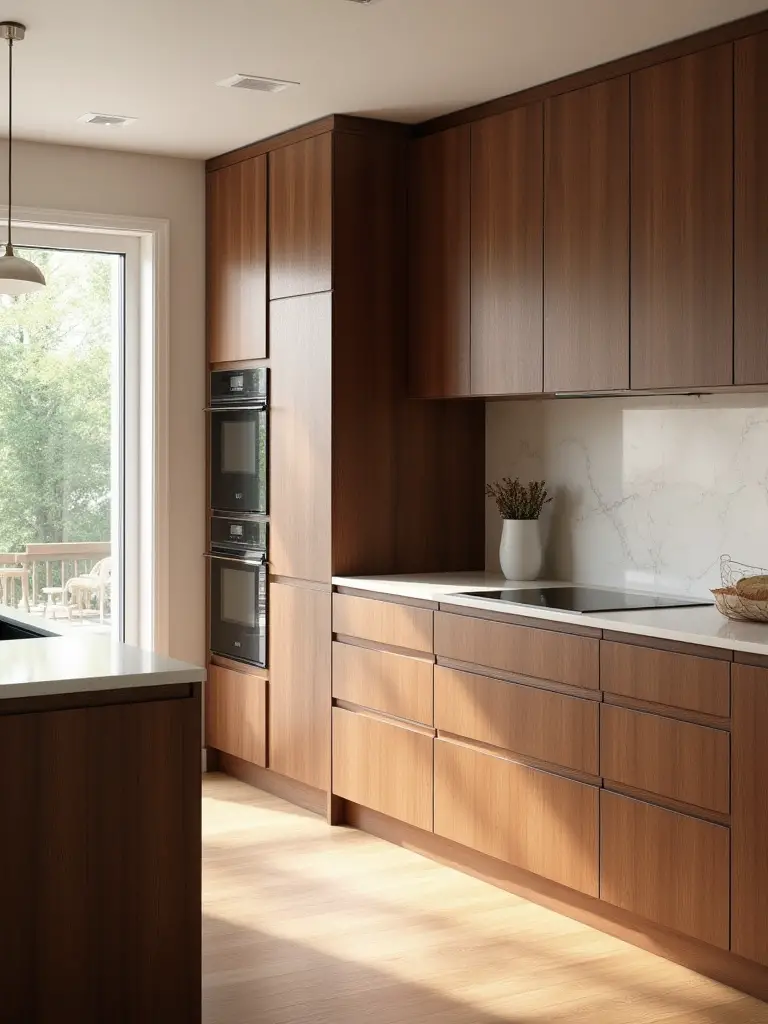
This level of customization completely changes how you interact with your space. Nothing gets lost in the back of a cabinet because everything is accessible. The result is an environment that stays effortlessly clean and organized because every single item has a logical home. It’s the silent hero of a high-end kitchen, creating that sense of calm and order that is the ultimate luxury.
The flawless exterior is just the beginning; the real value is in the intuitive functionality hidden behind those beautiful doors.
8. Select High-Performance, Integrated Professional-Grade Appliances
There’s a reason you see brands like Sub-Zero, Wolf, and Miele in high-end projects. It’s about performance, yes—precise temperature control, powerful burners—but it’s equally about design integration. In a luxury kitchen, appliances don’t just sit there; they disappear. Refrigerators, dishwashers, and even wine coolers are often “panel-ready,” meaning they are designed to be fitted with a custom cabinet panel that matches the rest of your kitchen.
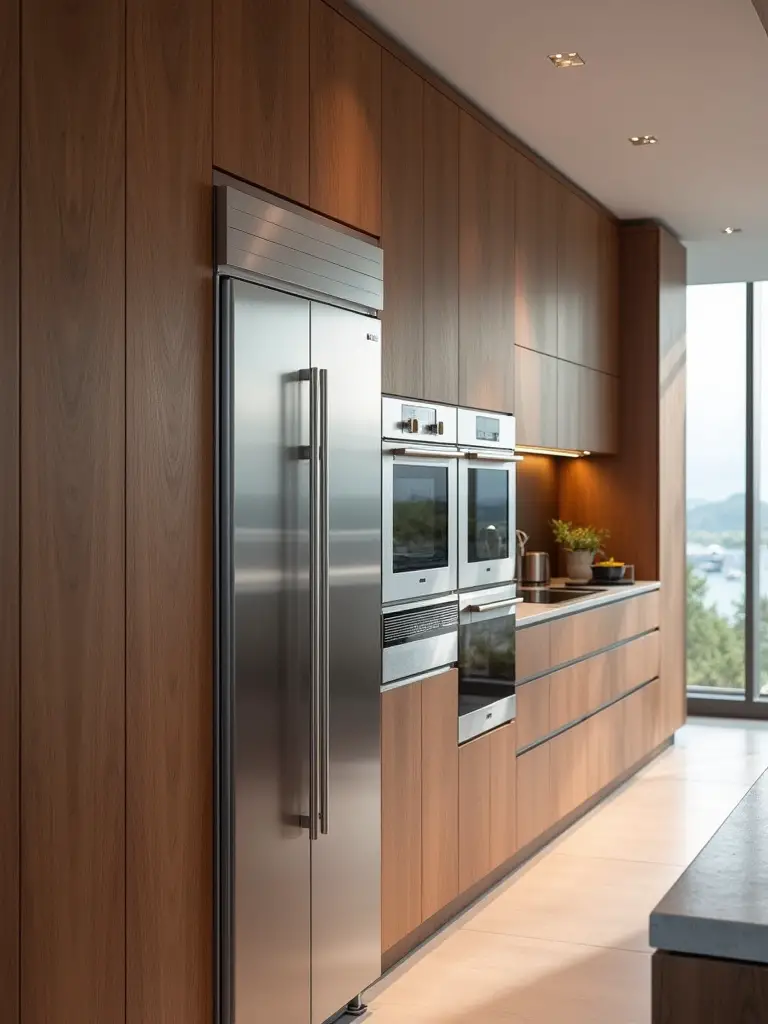
This creates a seamless, cohesive look that I, as a photographer, absolutely love. It shifts the focus from the machines to the overall architectural beauty of the space. Your eye follows the clean lines of the cabinetry without interruption. The exception is often the range, which can serve as a stunning, jewel-like centerpiece. It’s a strategic choice: what do you want to hide, and what do you want to feature?
Getting this right requires meticulous planning between your designer and cabinet maker to ensure every panel fits with micron-level precision.
9. Choose Distinctive Countertop Materials for Both Beauty and Durability
The countertop is the primary work surface and a major visual statement. Everyone defaults to thinking about marble or granite, but the world of luxury materials is so much bigger. While natural stone is beautiful, it can be porous and require sealing. For a kitchen that’s meant to be heavily used, I often point clients toward high-end engineered quartz or newer materials like sintered stone (think Dekton or Neolith).
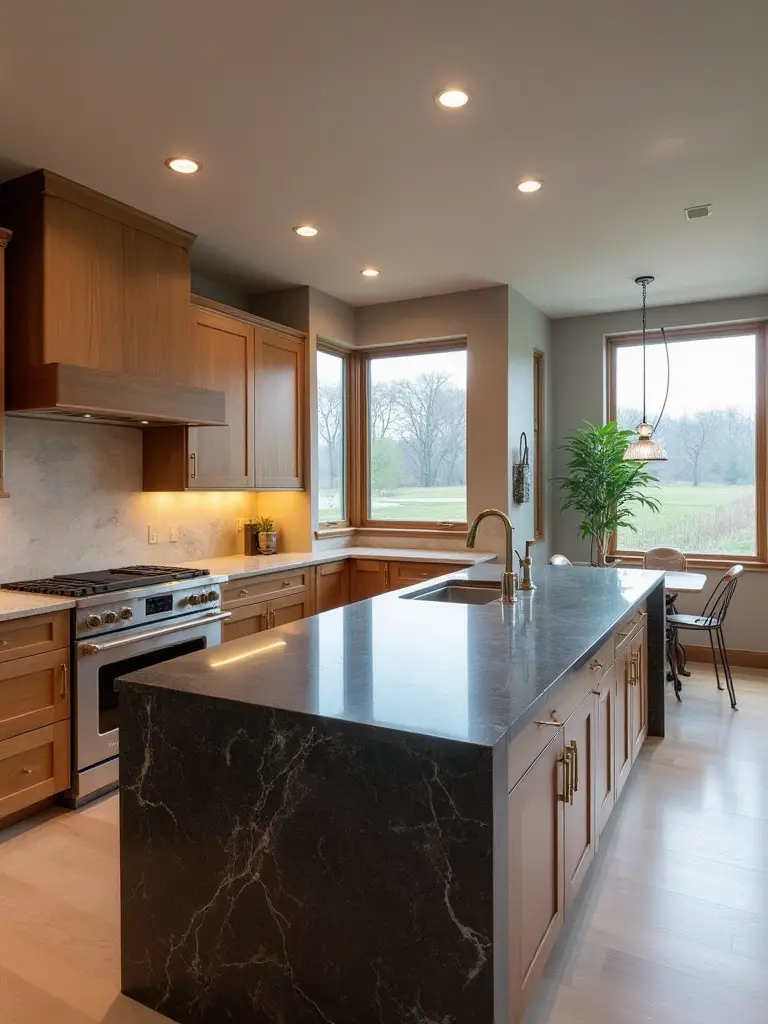
These materials offer incredible durability—they’re resistant to scratches, stains, and heat—while providing a huge range of aesthetics, from perfect marble look-alikes to solid industrial concrete styles. A massive trend right now is the “waterfall edge,” where the countertop material continues vertically down the side of an island, creating a bold, monolithic look. It’s a photographer’s dream, creating a strong, clean line that grounds the entire space.
Get large samples and view them in your actual kitchen light. The way a material looks under showroom lights can be completely different from how it looks in your home.
10. Design an Intelligent Lighting Scheme for Ambiance and Task Efficiency
Can we talk about why everyone gets lighting wrong? They stick a few recessed cans in the ceiling and a pendant over the island and call it a day. This is one of the biggest missed opportunities in a renovation. A luxury kitchen requires a layered lighting scheme with independent controls, just like in a high-end hotel or restaurant.
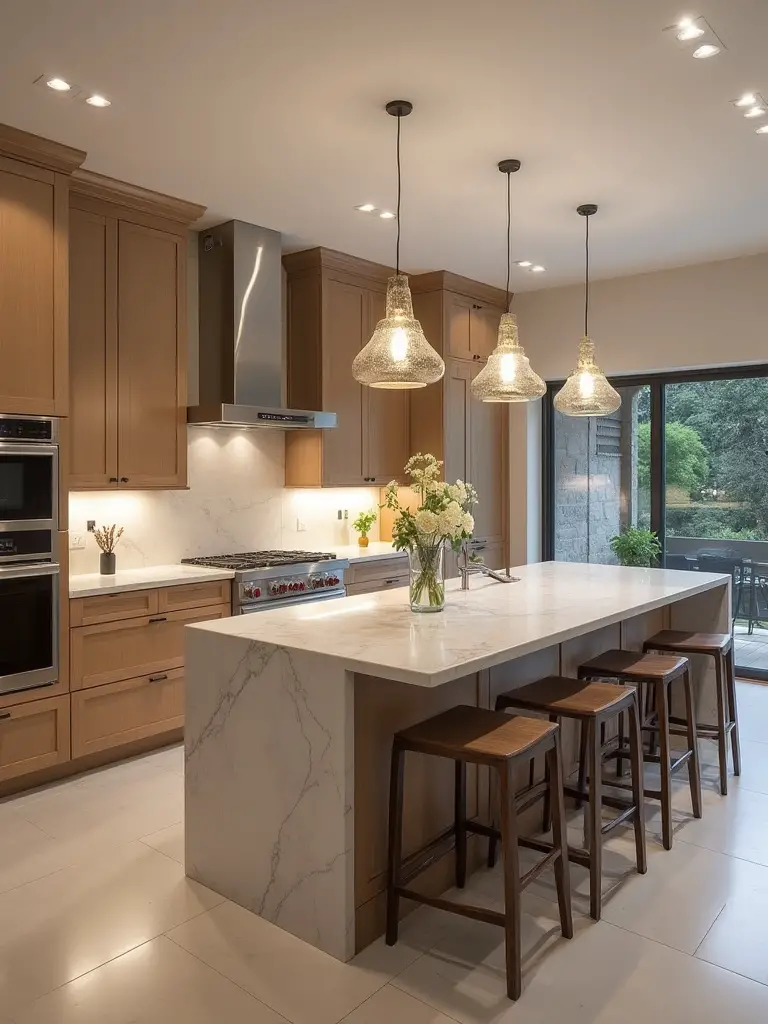
You need four layers: Ambient (general overhead light), Task (focused light for work areas, like under-cabinet LEDs), Accent (light that highlights architectural features, like inside glass cabinets), and Decorative (the “jewelry,” like a statement chandelier). Each layer should be on a separate dimmer. This allows you to completely transform the mood of the room—from bright and functional for cooking to soft and atmospheric for entertaining—with the touch of a button.
My pet peeve is seeing shadows cast on the countertops because the only light source is behind the person working. Under-cabinet lighting is non-negotiable. It is the single most important task light in your entire kitchen.
Elevated Choices: Materials, Appliances, and Expert Execution (Part 2)
We’re moving from the big-ticket items to the foundational and utility choices that might seem less glamorous but are absolutely critical for achieving that feeling of refined quality.
11. Install Premium Flooring Materials That Elevate the Space
Flooring is the fifth wall of your kitchen. It’s the visual foundation that everything else rests on, so don’t treat it as an afterthought. In a luxury context, you want something that offers durability, comfort underfoot, and a seamless transition to adjoining spaces. Large-format porcelain tiles are a fantastic choice because they’re nearly indestructible and have minimal grout lines, which creates a clean, expansive feel.
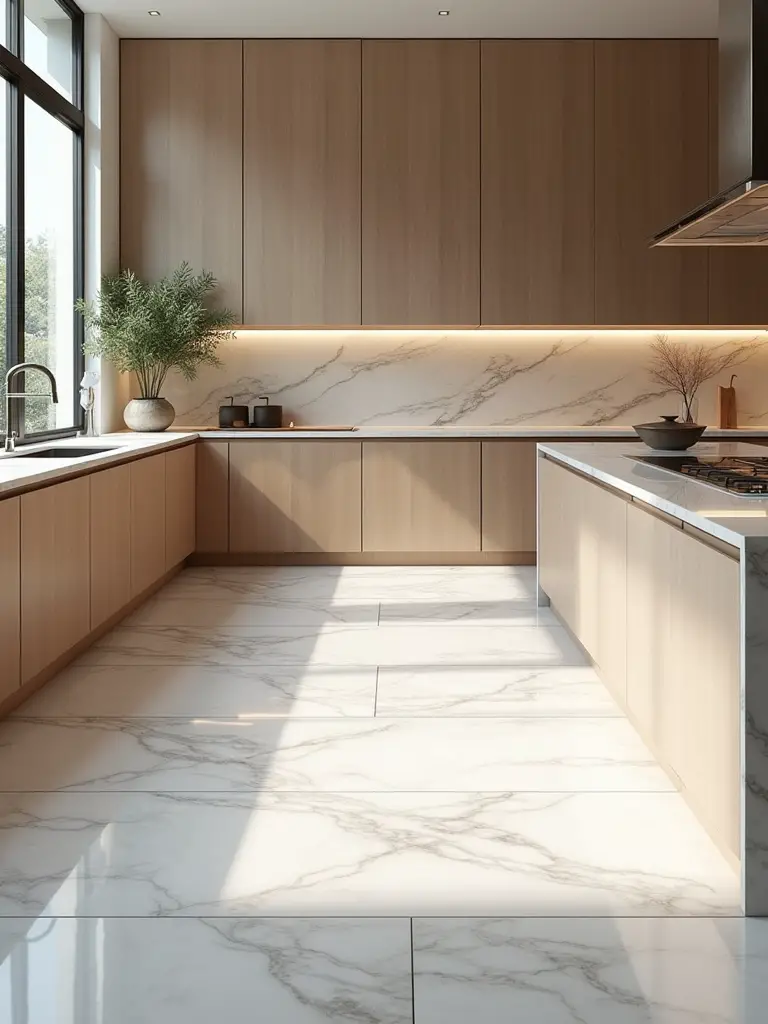
If you love the warmth of wood, high-quality engineered hardwood is more stable in a kitchen environment than solid wood. And for ultimate comfort, especially under tile or stone, integrating radiant underfloor heating is a game-changer. It’s a silent luxury—you can’t see it, but you can feel it. On a cold morning, a warm floor is an unparalleled comfort.
From a photographic perspective, the flooring choice dramatically affects how light bounces around the room. A lighter, slightly reflective floor will make the entire space feel brighter and larger.
12. Integrate Advanced Water Filtration and Dispensing Systems
This is one of those features that, once you have it, you can’t imagine living without. I’m talking about a dedicated tap that delivers instant boiling water, chilled filtered water, and even sparkling water on demand. Brands like Quooker and Zip have perfected these systems, integrating them into a single, elegant faucet.
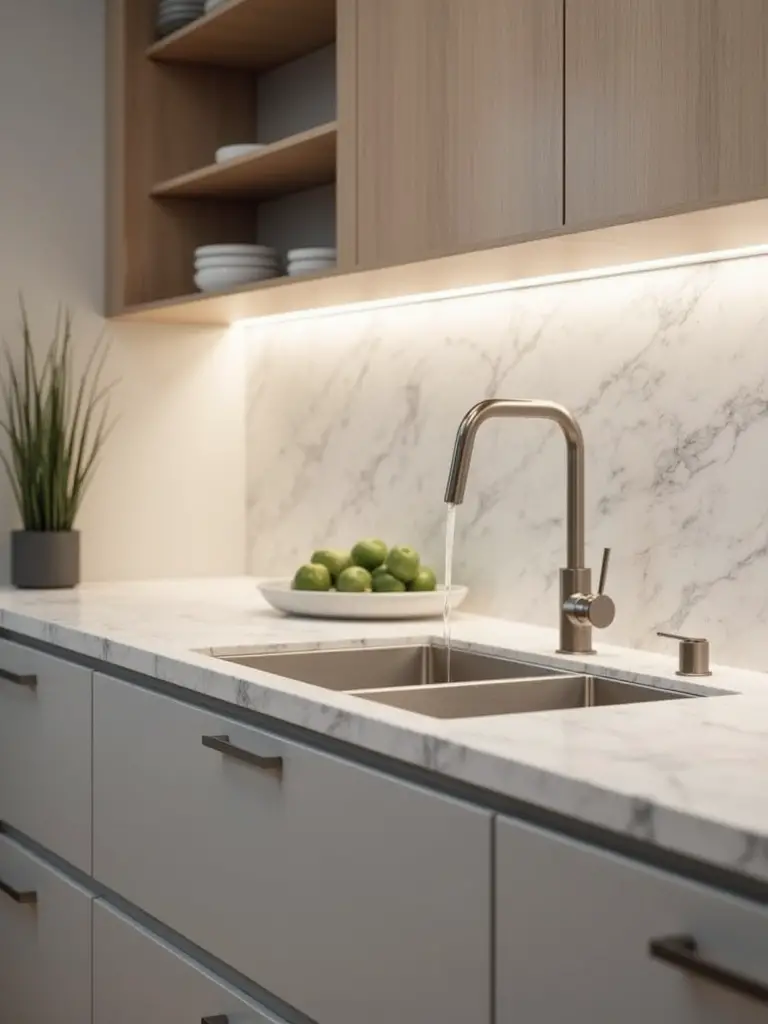
It completely streamlines so many daily tasks—making tea or coffee, filling a pot to boil pasta, getting a quick glass of cold water. It also declutters your kitchen entirely. You can get rid of the kettle on the counter, the Brita filter in the fridge, and the SodaStream taking up space. It’s the epitome of functional minimalism and a detail that signals a truly high-end, thoughtfully designed kitchen.
These systems require professional installation and need to be planned for early, as they have specific plumbing and electrical requirements, but the payoff in daily convenience is immense.
Sophisticated Design and Smart Enhancements (Part 1)
Now we move beyond the physical materials and into the brain of the kitchen. This is where we integrate technology and clever design to create a space that’s not just beautiful, but brilliant.
13. Implement a State-of-the-Art Smart Home Automation Hub
A smart kitchen is more than a fridge that tells you when you’re out of milk. A truly smart luxury kitchen uses a centralized hub (like Control4 or Savant) to orchestrate everything. Imagine saying, “Hey Google, start morning mode.” The lights slowly brighten to a cool white, your favorite news podcast starts playing on discreet in-ceiling speakers, and the coffee machine begins to brew.
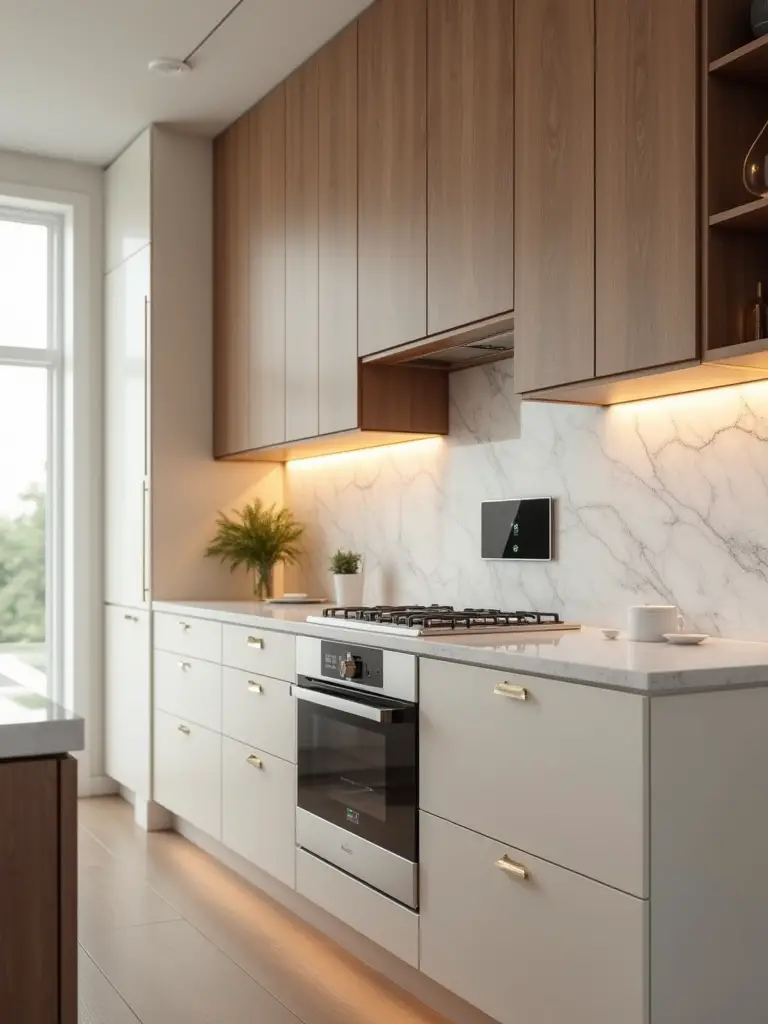
This isn’t about gadgets for the sake of gadgets. It’s about creating an environment that responds to you and simplifies your routines. The key is seamless integration. You don’t want to be juggling ten different apps to control your lights, blinds, oven, and speakers. A professional integrator will program a central system that controls everything from a single sleek touchscreen, your phone, or a simple voice command.
“The true luxury of automation isn’t controlling your oven from the car. It’s creating ‘scenes’ that transform the entire atmosphere of your kitchen with a single touch, effortlessly shifting from ‘prep’ to ‘dine’ to ‘entertain’.”
This level of control makes the technology disappear into the background, leaving you with pure convenience.
14. Integrate a Discreet, High-Capacity Wine and Beverage Center
Serious entertaining requires serious beverage storage. Cramming bottles of wine and cans of seltzer into your main refrigerator is inefficient and looks messy. A dedicated, integrated beverage center is essential. We’re not talking about a noisy dorm fridge. We’re talking about whisper-quiet, panel-ready units with dual temperature zones—one for your red wines and another for whites, champagne, and other drinks.
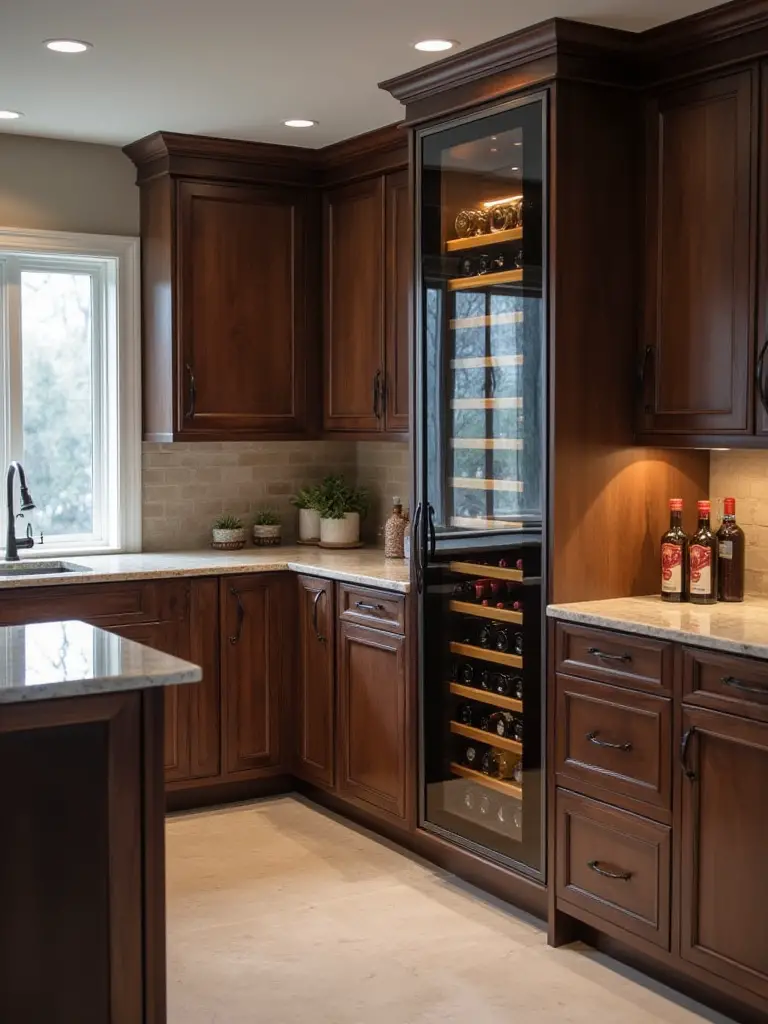
The key here is “integrated.” Like the main refrigerator, these units are designed to be hidden behind Custom Cabinetry panels, making them completely disappear. You can place them in the island for easy access during parties, or create a dedicated bar area away from the main cooking zone. It keeps guest traffic out of your workflow and ensures everything is served at its optimal temperature.
It’s a detail that elevates your hosting game from amateur to professional, making guests feel well cared for in a space that feels calm and organized.
15. Create a Dedicated Breakfast Nook or Coffee Bar Area
In a well-designed home, every routine has a dedicated space. The morning coffee ritual is a perfect example. A dedicated coffee bar—even a small one—can transform your mornings. This isn’t just a corner of the counter; it’s a purpose-built zone. Think a plumbed-in espresso machine (no more filling water tanks), drawers designed specifically for pods and supplies, and open shelving for your favorite mugs.
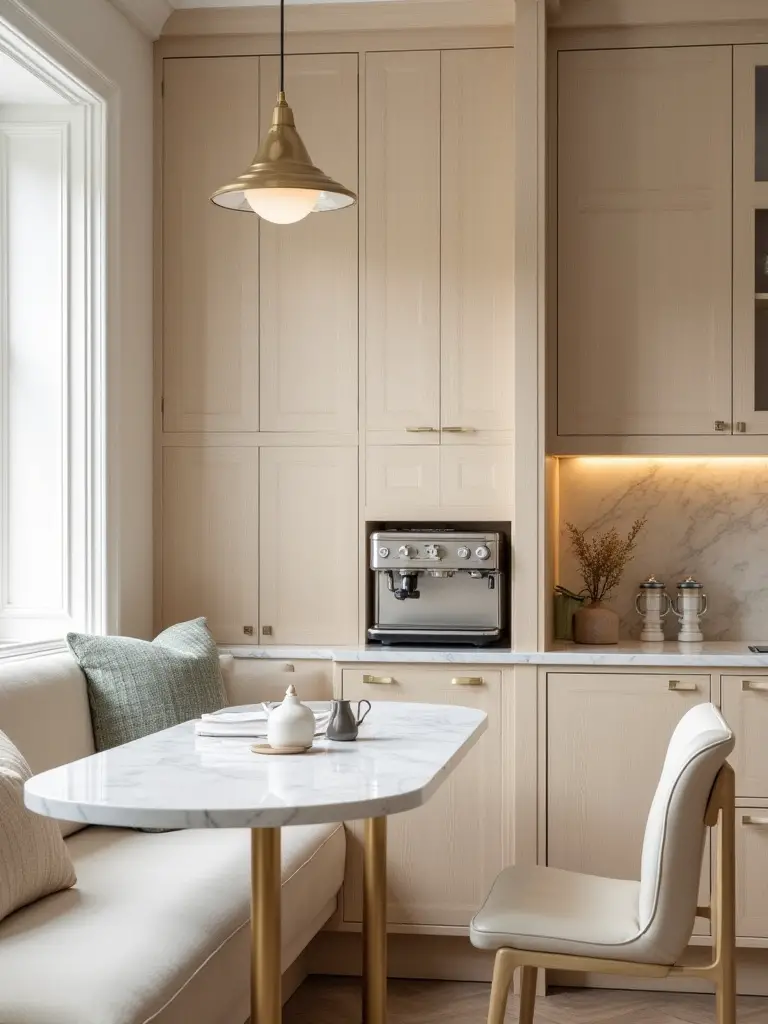
By centralizing everything you need for that first cup of the day, you reduce clutter across the main kitchen counters and create a pleasant, self-contained ritual. A breakfast nook serves a similar purpose, providing a comfortable, intimate spot for casual meals that keeps daily traffic out of the primary work zones. It’s especially valuable in homes with kids, giving them their own space for snacks and homework.
These dedicated zones are what turn a kitchen into the true heart of the home—a multi-functional space designed for the realities of modern life.
16. Optimize the Kitchen Island for Multifunctional Utility and Socializing
The kitchen island has evolved from a simple prep surface into the command center of the modern home. A luxury island needs to be a multifunctional workhorse. One side can be dedicated to work, with a prep sink, induction cooktop, and deep drawers for pots. The other side should be for socializing, with comfortable seating, a durable countertop, and hidden power outlets for laptops and phones.
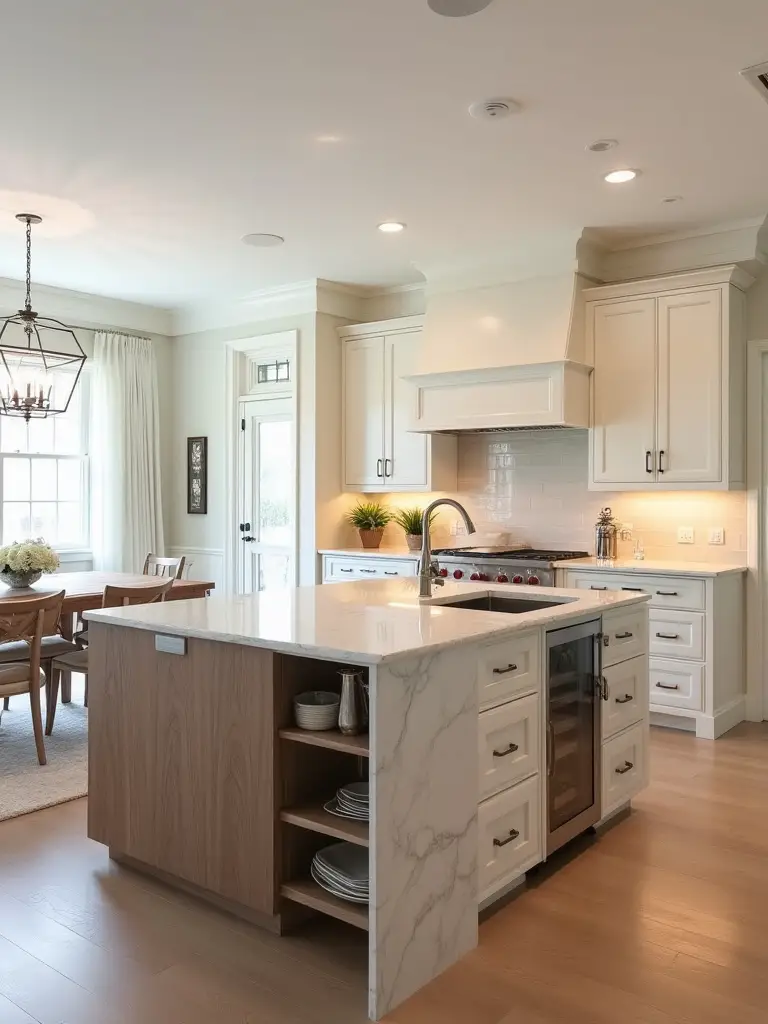
A split-level design is a brilliant way to achieve this. You can have the working side at a standard 36-inch counter height and elevate the seating side to a 42-inch bar height. This small level change creates a subtle but effective psychological separation between the “chef’s zone” and the “guest zone,” allowing for easy conversation without guests feeling like they’re in the way of the cooking.
The island dictates the entire flow of the kitchen. Getting its design, scale, and functionality right is absolutely critical.
Sophisticated Design and Smart Enhancements (Part 2)
We’re zeroing in on the details that provide the finishing touch—the elements you interact with up close. This is where craftsmanship and artistry really shine.
17. Select Luxury Fixtures and Hardware for Touchpoint Excellence
Fixtures and hardware are the jewelry of the kitchen. This is where you can feel the quality. The weight of a solid brass cabinet pull, the smooth action of a high-end faucet—these are the details your hands notice every single day. Skimping here is a classic mistake. I’ve seen stunning, expensive custom cabinetry ruined by flimsy, cheap hardware. It’s like wearing a bespoke suit with plastic shoes.
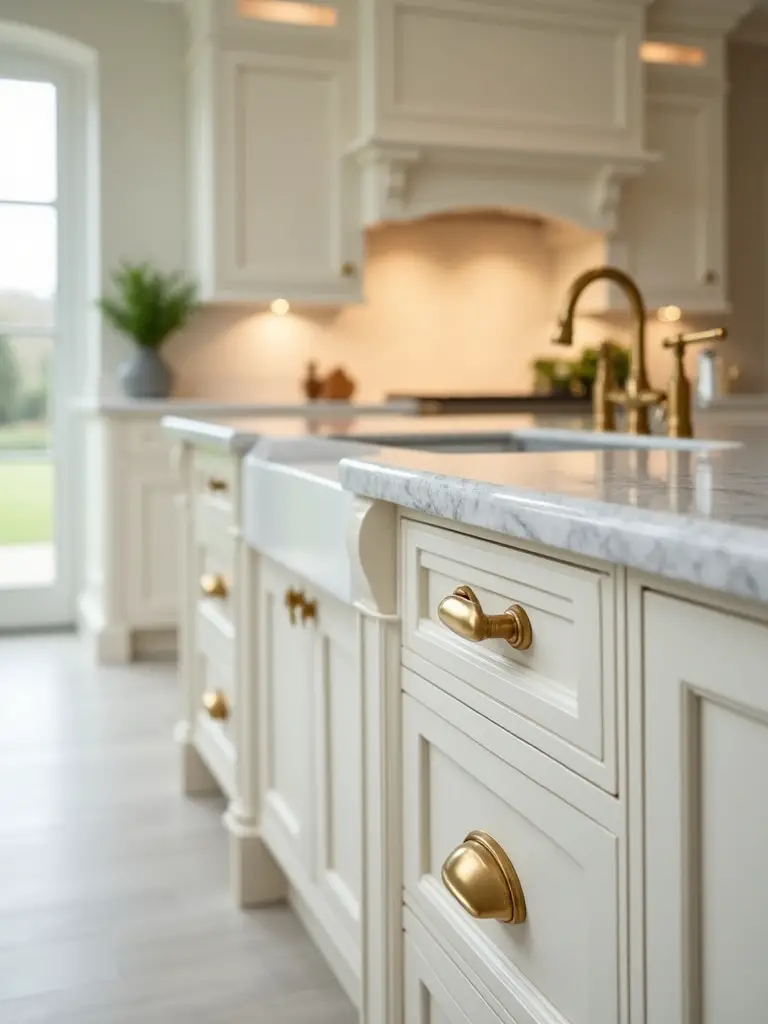
Think beyond chrome. Explore living finishes like unlacquered brass that will develop a beautiful, unique patina over time. Consider the ergonomics—how does that handle feel in your hand? Is the faucet pull-down sprayer easy to use? Brands like Waterworks, Dornbracht, and Kallista offer a level of engineering and design that you just won’t find at a big box store.
This is a place to allocate a real part of your budget. These touchpoints define the daily experience of using your kitchen and are a constant reminder of the quality of the renovation.
18. Design Custom Backsplashes as Artistic Focal Points
Forget boring 4×4 subway tiles. A backsplash in a luxury kitchen is an opportunity to make an artistic statement. The most impactful approach is using a full-height, solid slab of stone—like marble or quartzite—to match the countertops. Running the same material up the wall creates a dramatic, seamless, and incredibly clean look. It’s a bold move that eliminates grout lines and turns the wall into a piece of natural art.
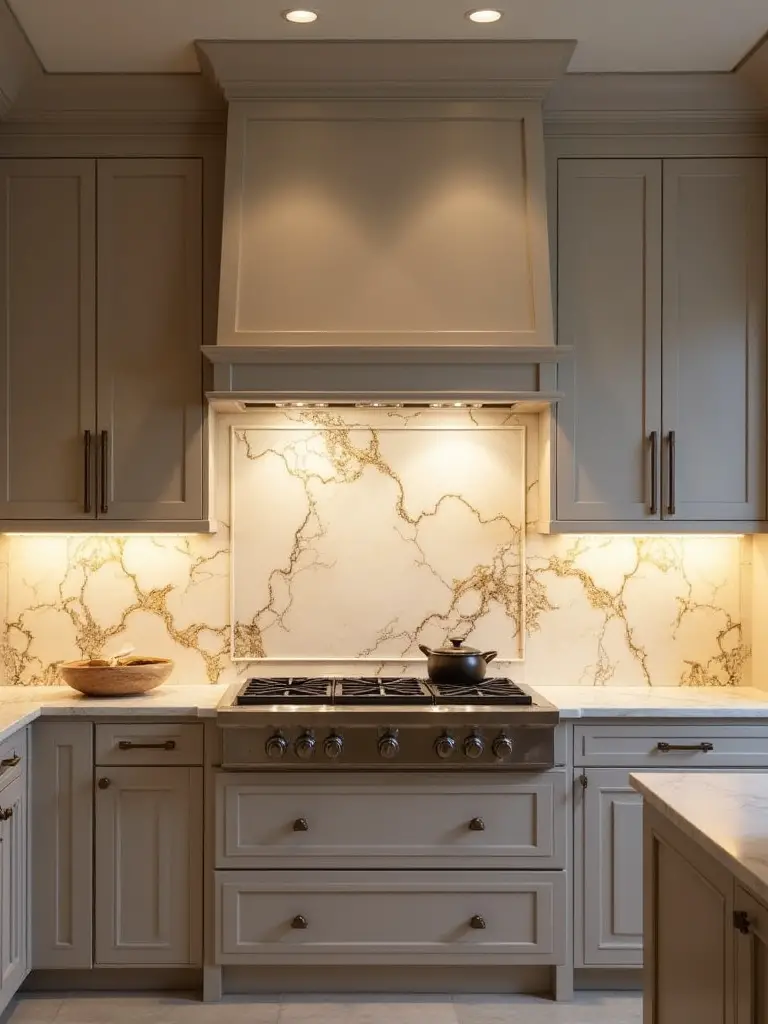
From a photographer’s perspective, this is a showstopper. It creates a powerful focal point, especially behind the range. If a full slab isn’t in the budget or style, consider handcrafted Zellige tiles, which have beautiful, subtle variations in color and texture, or a custom mosaic that adds a personal touch. The key is to see the backsplash not as a utility but as a canvas.
And don’t forget to light it properly. A wash of light from under-cabinet LEDs will graze across the surface and bring out all the beautiful texture and detail.
Sustaining Grandeur: Ensuring Longevity, Maintenance, and Futureproofing (Part 1)
The renovation is done, but the work isn’t. A luxury kitchen is a high-performance machine. You wouldn’t buy a Ferrari and never change the oil. Protecting your investment requires a smart approach to organization and maintenance from day one.
19. Plan for Smart Storage Solutions Beyond Traditional Cabinetry
We talked about custom cabinetry, but let’s go deeper. Smart storage is about using clever mechanical solutions to make every inch accessible. Think beyond shelves. Pull-out pantry systems bring the entire contents of your pantry out to you. “Magic Corner” or LeMans units for blind corner cabinets use brilliant swinging trays to ensure nothing ever gets lost in the void.
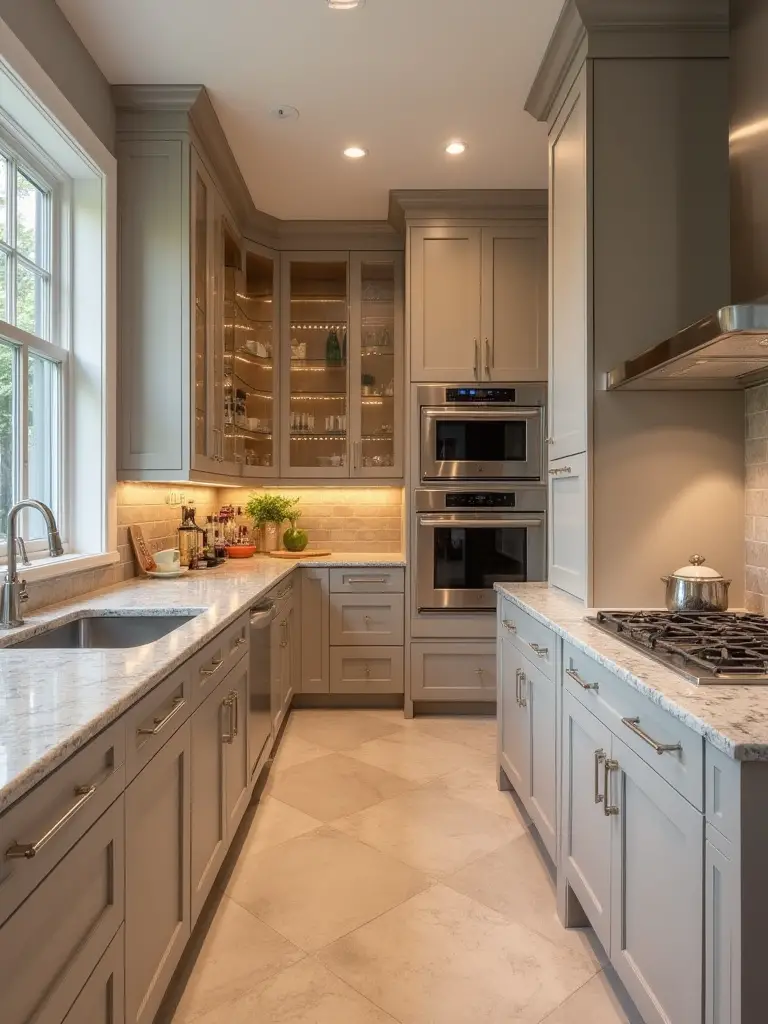
Vertical storage is another key. Use dividers in deep drawers to store baking sheets, cutting boards, and platters on their sides, so you can just grab one without unstacking everything. My favorite shortcut? Toe-kick drawers. That 4-inch space under your base cabinets is usually wasted. It’s the perfect spot for storing flat items like serving trays, pet bowls, or your emergency chocolate stash.
These solutions aren’t cheap, but they transform the daily usability of your kitchen. The ultimate luxury is an uncluttered countertop, and that is only possible with hyper-organized storage behind the scenes.
20. Incorporate Hidden Charging Stations and Device Integration
Cables are the enemy of a clean aesthetic. A luxury kitchen in 2024 needs dedicated, hidden spots for charging phones, tablets, and laptops. This is easy to plan for but almost impossible to retrofit cleanly. The simplest solution is to dedicate a “tech drawer” with a built-in power strip. You open the drawer, plug in your devices, and close it. Clutter gone.
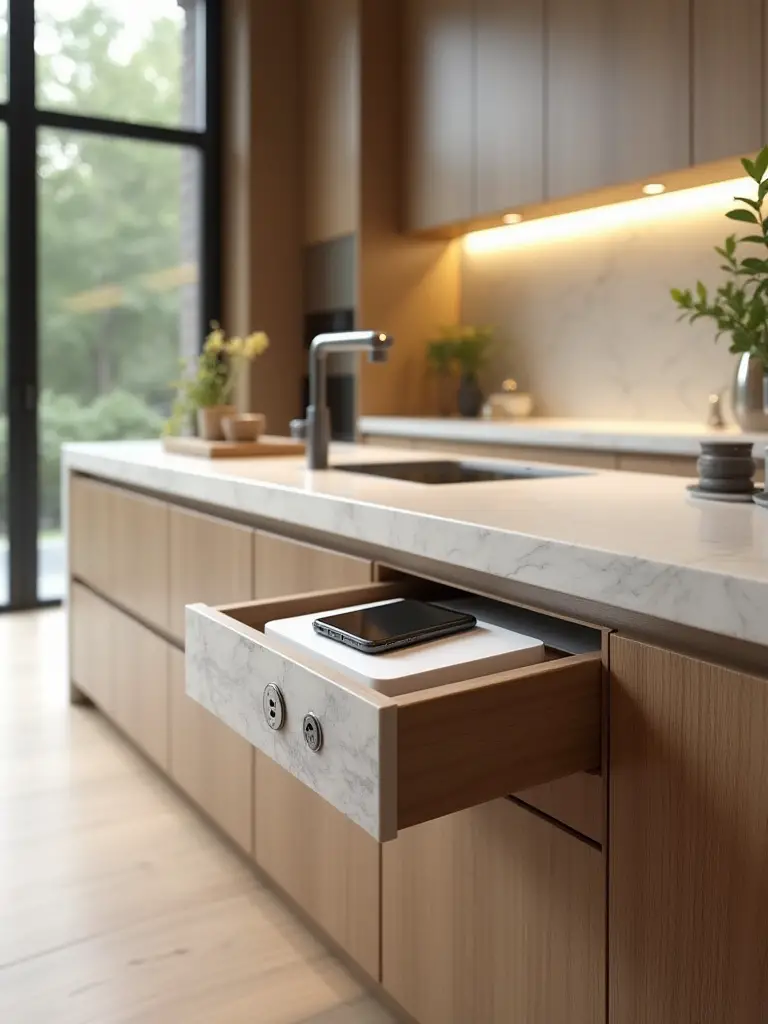
For an even sleeker solution, you can integrate wireless charging pads directly underneath your countertop. You just place your phone on a designated spot on the counter, and it starts charging invisibly. You can also integrate outlets into pop-up towers on the island or run them along a discreet strip underneath your upper cabinets.
This is a small detail that has a huge impact on the daily tidiness and functionality of your space, keeping your valuable tech safe from spills and your counters clear of cable spaghetti.
21. Establish a Professional Cleaning and Maintenance Schedule
This is the hard truth nobody likes to hear: high-end materials require high-end care. You can’t use Windex on an unlacquered brass faucet or a harsh abrasive on honed marble. Each surface and appliance will have a specific cleaning and maintenance protocol, and if you don’t follow it, you can cause irreversible damage and void warranties.
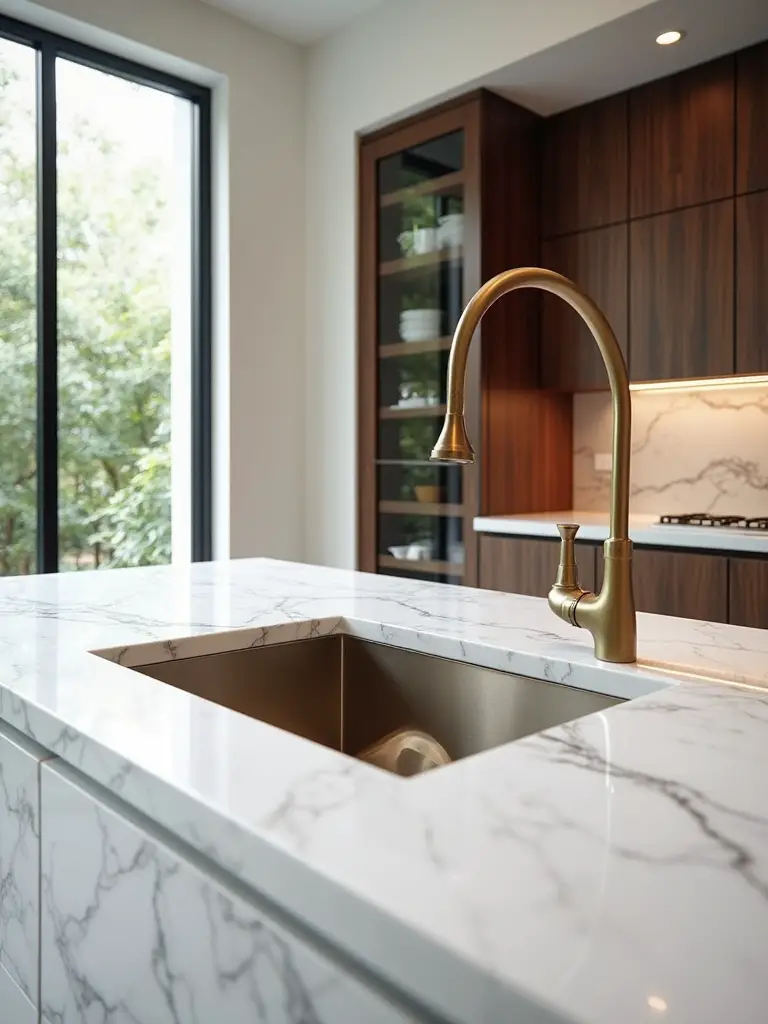
For natural stone countertops, this means having them professionally sealed every year or two. For your professional-grade appliances, it might mean a yearly service checkup by a certified technician to ensure everything is running at peak performance. Create a household manual with the care instructions for every single finish and product in your kitchen.
It may seem like overkill, but this proactive approach is what will keep your six-figure kitchen looking brand new ten years from now. It’s about protecting the asset you’ve worked so hard to create.
22. Understand Warranty Coverage and Service Plans for High-End Products
When you’re buying a $15,000 range or a $12,000 refrigerator, the warranty is part of the product. Don’t just file it away. Read it. Understand what’s covered (and what’s not) and for how long. Register every single appliance with the manufacturer as soon as it’s installed. This is crucial for getting timely and qualified service if something goes wrong.
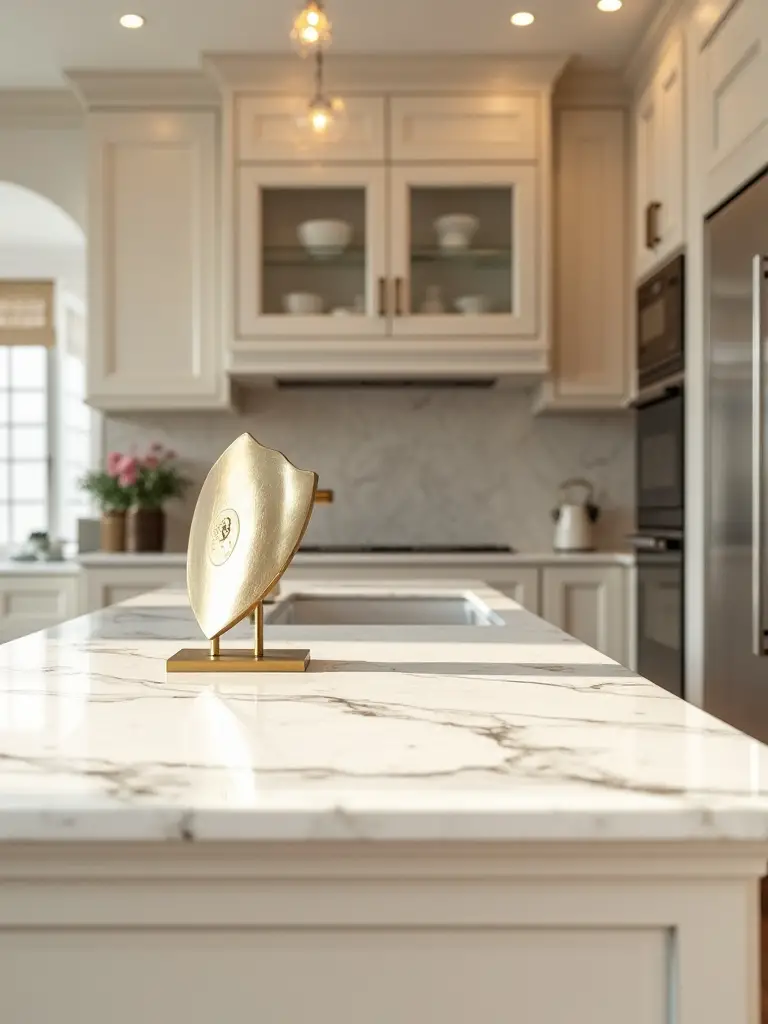
Seriously consider the extended service plans offered by the manufacturer. I know they can feel like an upsell, but for complex, high-end appliances, they are often worth it. These plans ensure that only factory-certified technicians using authentic parts will work on your machine, which is critical. A general appliance repair person can easily cause more damage to a sophisticated piece of equipment.
Keep all your receipts, model numbers, serial numbers, and warranty documents in a single, organized folder. You’ll be incredibly thankful you did when you need them.
Sustaining Grandeur: Ensuring Longevity, Maintenance, and Futureproofing (Part 2)
Finally, we look to the future. A great design isn’t just for today; it’s a platform that can adapt and evolve over time, ensuring your kitchen remains relevant for decades to come.
23. Design for Adaptability and Future Technology Upgrades
The last thing you want is for your brand-new kitchen to feel dated in five years because of some new technology you couldn’t anticipate. You can’t predict the future, but you can plan for it. The smartest way to do this is by building in flexibility from the start. Have your electrician run empty conduit inside the walls to key locations. This creates a clear, accessible pathway to pull new wires in the future—for new data, audio, or power needs—without tearing open the drywall.
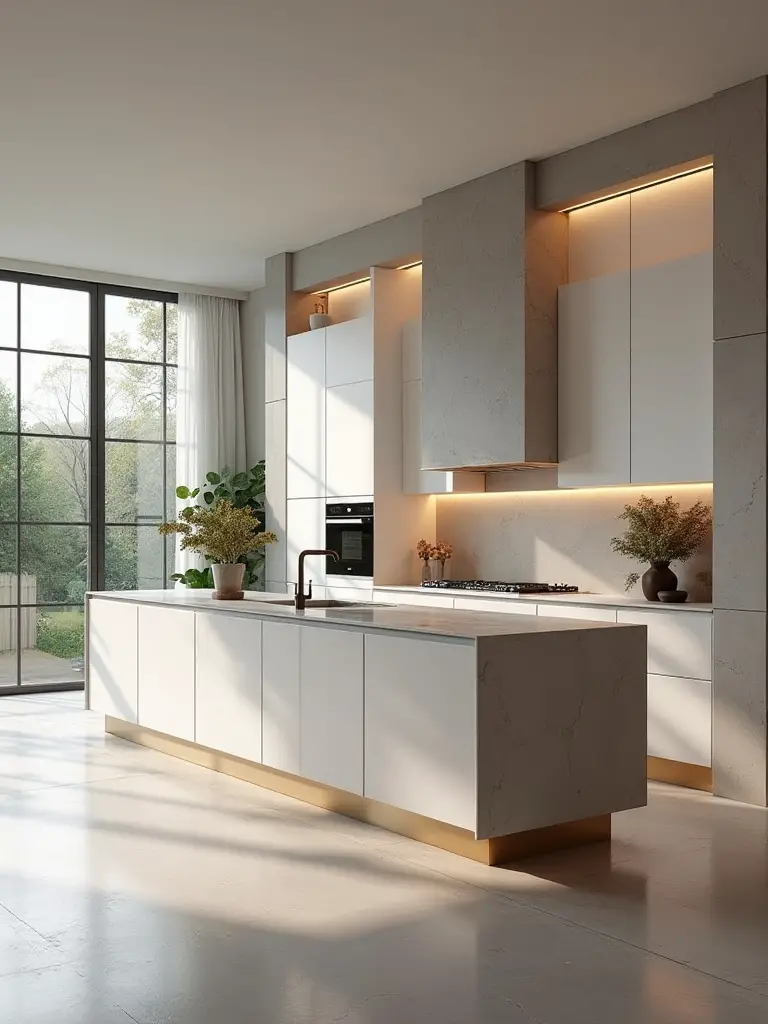
Another key is to use standardized appliance sizes where possible. While everything is custom, sticking to common dimensions (e.g., a 30″ or 36″ cabinet for a wall oven) will make it much easier to replace that appliance in ten years when a new model comes out. Also, opting for a modular lighting system, like track lighting, allows you to change or reposition fixtures as your needs or tastes evolve.
It’s about building a beautiful “chassis” that can easily accommodate new “engines” as technology progresses. This foresight is the final element that separates a merely expensive kitchen from a truly intelligent, long-lasting investment.
Conclusion
So there you have it. A luxury kitchen renovation is a complex puzzle, but it’s not a mystery. It’s a series of deliberate choices, layered on top of one another, all guided by a clear vision for how you want to live. It’s about valuing function as much as form, a photographer’s sense of light and composition as much as a chef’s need for an ergonomic workflow, and an engineer’s foresight as much as an artist’s touch.
Don’t get overwhelmed by the checklist. Instead, see this as a roadmap. Focus on getting that initial foundation right, partner with experts you trust, and never lose sight of the end goal: creating a space that not only wows your guests but brings a small moment of joy and ease to your life, every single day. That’s a luxury worth investing in.
